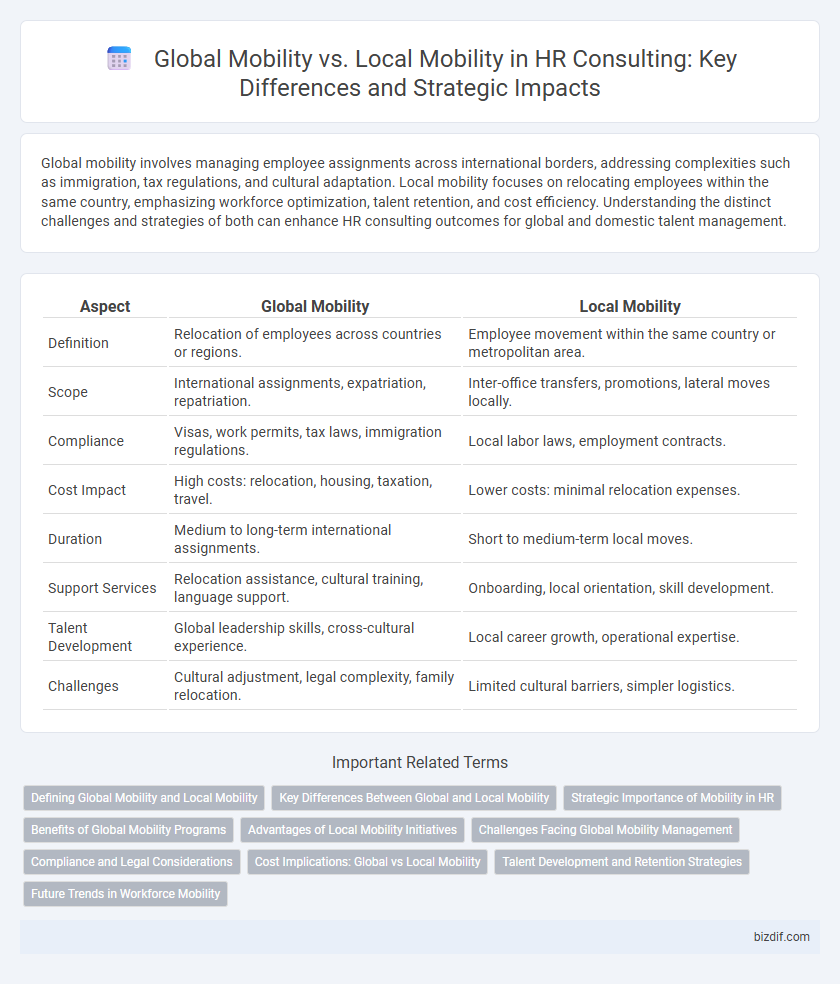Global mobility involves managing employee assignments across international borders, addressing complexities such as immigration, tax regulations, and cultural adaptation. Local mobility focuses on relocating employees within the same country, emphasizing workforce optimization, talent retention, and cost efficiency. Understanding the distinct challenges and strategies of both can enhance HR consulting outcomes for global and domestic talent management.
Table of Comparison
| Aspect | Global Mobility | Local Mobility |
|---|---|---|
| Definition | Relocation of employees across countries or regions. | Employee movement within the same country or metropolitan area. |
| Scope | International assignments, expatriation, repatriation. | Inter-office transfers, promotions, lateral moves locally. |
| Compliance | Visas, work permits, tax laws, immigration regulations. | Local labor laws, employment contracts. |
| Cost Impact | High costs: relocation, housing, taxation, travel. | Lower costs: minimal relocation expenses. |
| Duration | Medium to long-term international assignments. | Short to medium-term local moves. |
| Support Services | Relocation assistance, cultural training, language support. | Onboarding, local orientation, skill development. |
| Talent Development | Global leadership skills, cross-cultural experience. | Local career growth, operational expertise. |
| Challenges | Cultural adjustment, legal complexity, family relocation. | Limited cultural barriers, simpler logistics. |
Defining Global Mobility and Local Mobility
Global Mobility involves relocating employees across international borders to support business operations, talent acquisition, and cultural integration, encompassing visa management, expatriate assignments, and compliance with global labor laws. Local Mobility refers to the movement of employees within the same country, including transfers between cities or regions, aimed at optimizing workforce deployment, enhancing career development, and addressing local talent needs. Both mobility types require tailored HR strategies to manage logistical, legal, and cultural challenges effectively.
Key Differences Between Global and Local Mobility
Global mobility involves relocating employees across international borders, requiring compliance with diverse immigration laws, tax regulations, and cultural adaptations. Local mobility focuses on internal transfers within a single country, emphasizing regional labor laws and minimizing cross-border complications. Key differences include the complexity of legal requirements, cost implications, and the scope of logistical coordination for managing talent mobility.
Strategic Importance of Mobility in HR
Global mobility enables organizations to leverage diverse talent pools and optimize workforce alignment across international markets, enhancing competitive advantage. Local mobility focuses on internal career development and retention, improving employee engagement and operational agility within domestic regions. Strategic integration of both mobility types ensures a dynamic HR framework that supports business growth and talent optimization worldwide.
Benefits of Global Mobility Programs
Global Mobility programs enhance talent acquisition by providing access to a diverse international workforce, fostering innovation through cross-cultural collaboration. They support employee development with immersive global experiences that build leadership skills and adaptability in dynamic markets. Organizations benefit from improved business agility, enabling seamless operations across borders and better alignment with global strategic goals.
Advantages of Local Mobility Initiatives
Local mobility initiatives enhance employee retention by enabling career growth within familiar environments, reducing relocation costs and cultural adjustment challenges. They foster stronger organizational loyalty and adaptability by leveraging local talent pools and regional knowledge. Investing in local mobility supports diverse workforce development and agility in responding to market-specific demands.
Challenges Facing Global Mobility Management
Global mobility management faces significant challenges including navigating complex immigration laws, tax compliance across multiple jurisdictions, and cultural adaptation for expatriates. Ensuring seamless coordination between global mobility and local HR teams is crucial to address varying compensation frameworks and employee expectations. Data security and managing cost-effectiveness remain persistent issues in global talent deployment compared to localized mobility initiatives.
Compliance and Legal Considerations
Global Mobility requires rigorous adherence to international labor laws, tax regulations, and immigration policies to ensure compliance across multiple jurisdictions, reducing risks of legal penalties and operational disruptions. Local Mobility focuses on compliance with domestic labor standards, employment contracts, and local taxation, emphasizing alignment with regional employment regulations and workforce integration. Effective HR consulting bridges these compliance frameworks by providing tailored legal guidance that mitigates risks and supports seamless employee transitions globally and locally.
Cost Implications: Global vs Local Mobility
Global mobility incurs higher costs due to international relocation expenses, tax compliance, visa processing, and expatriate allowances, significantly impacting HR budgets. Local mobility reduces expenses by leveraging existing infrastructure and minimizing legal complexities, resulting in lower overall labor costs. Companies must balance these cost implications with strategic talent deployment to optimize workforce mobility effectively.
Talent Development and Retention Strategies
Global Mobility programs enhance talent development by providing employees with international assignments that broaden skills and cultural competence, essential for leadership growth in multinational companies. Local Mobility strategies focus on internal talent rotations and promotions within domestic markets, promoting retention through career progression and alignment with regional business needs. Balancing global and local mobility initiatives drives comprehensive talent retention by addressing diverse development opportunities and optimizing workforce agility.
Future Trends in Workforce Mobility
Global mobility strategies increasingly emphasize digital integration and real-time analytics to optimize cross-border employee experiences, while local mobility leverages AI-driven platforms for seamless internal talent redeployment. Emerging trends highlight a hybrid approach, combining global assignments with short-term, remote, or gig-based projects to enhance workforce agility and reduce relocation costs. Future workforce mobility prioritizes sustainability and compliance, adapting to evolving geopolitical landscapes and employee well-being demands.
Global Mobility vs Local Mobility Infographic

 bizdif.com
bizdif.com